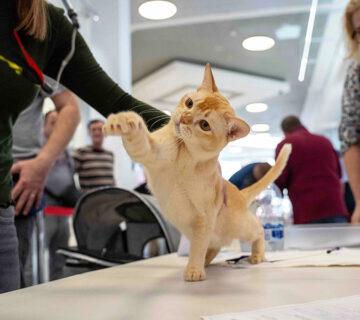Why are purebred cats so expensive?
Many cat lovers who are looking to purchase a pedigree cat may ask themselves this question.
Inspired by a visit to a pedigree cat exhibition or by an article in a cat magazine, many people want to own one of these beautiful animals.
The soon to be cat owners might experience a displeasure and disappointment when they first spot what seems to be a horrendous asking price of the breeders. And some will question themselves why they should spend so much money for a kitten, which they neither want to breed nor exhibit, and the pedigree might not see the daylight in years.
So why do the purebred Burmese cats cost so much?
Because the breeding is expensive! That’s the shortest answer.
Many people might think that cat breeding must be a very profitable business due to the cost of kittens, but for the majority of cat breeders, this is just not the case. The cost of a purebred kitten reflects the expenses of bringing these cats into the world. In this article, we take a look at just some of the costs which breeders bear.
Setup and maintenance costs
Setting up a cattery comes with a lot of set up expenses as well as ongoing costs.
Queen (female) and stud cat (male):
It will be necessary to buy some female cats with breeding rights. They must posses show and breeding quality, which means they are an excellent example of the breed. The original breeder of the female could, of course, include her in their own breeding programme. She will be sold at a premium price.
The gene pool for Burmese cats is not as large as the for some other popular cat breeds. Breeders must choose lines carefully to ensure they are not inbreeding. Often this will mean importing lines from overseas, for example from countries such as Australia. This implies additional costs of the special vaccinations and veterinary checks, flights, and quarantine.
Importing a breeding cat from overseas will cost between EUR 6,000 and EUR 8,000, with many breeders insisting on strict contracts before they can purchase a cat.
Housing a stud (male cat):
The costs rise if you have your own male (called a stud). It will be necessary to place him separately to avoid unplanned litters and spraying.
Health and genetic testing:
Some Burmese cats can have genetic diseases such as Ganglioside GM2 and Hypokalemia which breeder must rule out in their breeding cats. There is one way this can be achieved: genetic tests.
Registration fees:
A registered breeder must be affiliated with one of the Felinological associations which are present in the most countries. We are a member of the WCF (World Cat Federation). Annual fees cattery registration, as well as fees to register kittens are required.
The main goal of cat breeding isn’t to produce as many kittens as possible; it is to advance the breed. To produce the best possible progeny and expand lines. This costs time and money.
Exhibiting cats:
Exhibiting cats is an essential part of being a cat breeder so that the cats can be judged against the breed standard. Each show bears registration fees with it. Additionally, the breeder must also pay for show curtains, a bed, and in some cases, a show cage as well as transportation, meals, and accommodation.
Veterinary care:
All cats require veterinary care, at an absolute minimum, annual health check-up as well as regular parasite control for fleas and worms, but also vaccinations.
Pregnancy can be confirmed by a veterinarian, and after the kitten has given birth, a health check of both the queen and her kittens are necessary.
Annual health check for all cats.
Vaccinations of all cats, including two vaccinations for the kittens.
Emergency medical treatment can include disease, infection, difficulty giving birth, which may necessitate a caesarian section.
Food:
All cats, but in particular the breeding cats, and the kittens require a premium quality diet to maintain the best possible health. Queens and kittens require a kitten diet, healthy adults, a maintenance diet. The type and brand of food are of course up the personal choice and preference of the breeder.
As pregnancy progresses, the queen will need to eat more food, which is higher in calories (kitten food is best). Kittens start on solids from 4 weeks of age, and the amount of food consumed will increase as the weeks progress. A fully weaned kitten will eat four times a day.
Time:
Cat breeding consumes a lot of time, which can include:
- Cleaning litter trays and floors
- Feeding and grooming cats
- Cleaning the stud room
- Care for all cats
- Socialising kittens
- Time playing and interacting with the stud
- Answering inquiries about kittens over the phone or email
- Updating website or social media
- Preparation, travel to and from and exhibiting at cat shows
- Travel to and from the veterinarian for desexing, vaccinations, health checks
Kitten specific expenses
- Kitten registration
- Food
- Vaccinations
- Microchip
- Desexing
- Parasite control
- Veterinary care (emergency and general)
- Health guarantees
 en
en  de
de fr
fr


